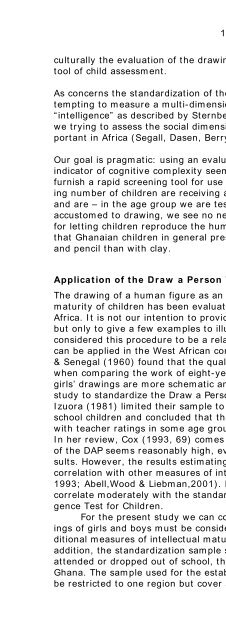4. The Draw a Person Test for Ghana
4. The Draw a Person Test for Ghana
4. The Draw a Person Test for Ghana
You also want an ePaper? Increase the reach of your titles
YUMPU automatically turns print PDFs into web optimized ePapers that Google loves.
15<br />
culturally the evaluation of the drawing of a human figure could not be a<br />
tool of child assessment.<br />
As concerns the standardization of the DAP <strong>Test</strong> in <strong>Ghana</strong>, we are not attempting<br />
to measure a multi-dimensional culturally indigenous concept of<br />
“intelligence” as described by Sternberg (2002) or Mpofu (2002). Nor are<br />
we trying to assess the social dimension of intelligence that seems so important<br />
in Africa (Segall, Dasen, Berry & Portinga, 1990,104-108).<br />
Our goal is pragmatic: using an evaluation of children’s drawings as an<br />
indicator of cognitive complexity seems adequate in <strong>Ghana</strong> in order to<br />
furnish a rapid screening tool <strong>for</strong> use of special educators. As an increasing<br />
number of children are receiving an education in the schools of <strong>Ghana</strong><br />
and are – in the age group we are testing- used to paper and pencil and<br />
accustomed to drawing, we see no necessity in using, <strong>for</strong> example, clay<br />
<strong>for</strong> letting children reproduce the human figure. In fact, it can be assumed<br />
that <strong>Ghana</strong>ian children in general presently are more familiar with paper<br />
and pencil than with clay.<br />
Application of the <strong>Draw</strong> a <strong>Person</strong> <strong>Test</strong> in West Africa<br />
<strong>The</strong> drawing of a human figure as an estimation of the level of intellectual<br />
maturity of children has been evaluated in a number of studies in West<br />
Africa. It is not our intention to provide an exhaustive list of such studies<br />
but only to give a few examples to illustrate that other authors have also<br />
considered this procedure to be a relatively “culture- reduced” test that<br />
can be applied in the West African context. Specifically, Bardel, Moreigne<br />
& Senegal (1960) found that the quality of children’s drawings regressed<br />
when comparing the work of eight-year-olds to seven-year-olds and that<br />
girls’ drawings are more schematic and detailed than those of boys. In a<br />
study to standardize the <strong>Draw</strong> a <strong>Person</strong> <strong>Test</strong> <strong>for</strong> Nigeria, Ebigbo and<br />
Izuora (1981) limited their sample to Enugu including urban and village<br />
school children and concluded that the scores of the test only correlated<br />
with teacher ratings in some age groups.<br />
In her review, Cox (1993, 69) comes to the conclusion that the reliability<br />
of the DAP seems reasonably high, even if there are some conflicting results.<br />
However, the results estimating the validity of the tests through<br />
correlation with other measures of intelligence are more varied (Cox,<br />
1993; Abell,Wood & Liebman,2001). In general, the results of the DAP<br />
correlate moderately with the standard of reference: the Wechsler Intelligence<br />
<strong>Test</strong> <strong>for</strong> Children.<br />
For the present study we can conclude that a comparison of drawings<br />
of girls and boys must be considered in standardization and that additional<br />
measures of intellectual maturity should be used in validation. In<br />
addition, the standardization sample should include children never having<br />
attended or dropped out of school, this still being a common occurrence in<br />
<strong>Ghana</strong>. <strong>The</strong> sample used <strong>for</strong> the establishment of norms should also not<br />
be restricted to one region but cover all of <strong>Ghana</strong>.






